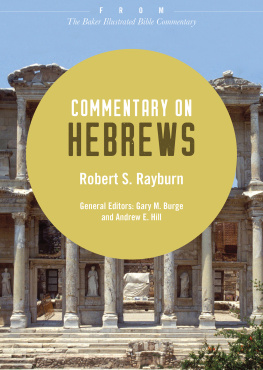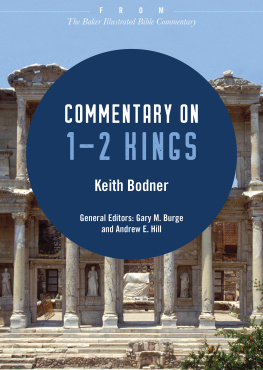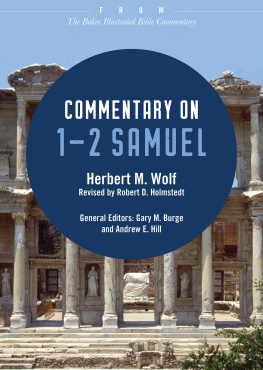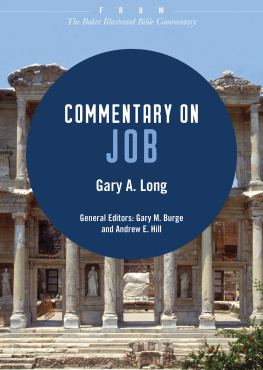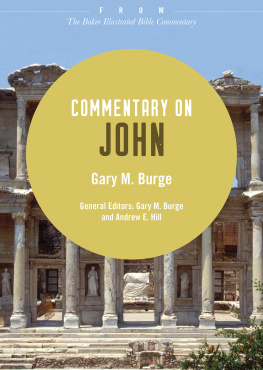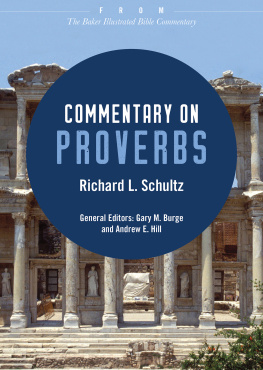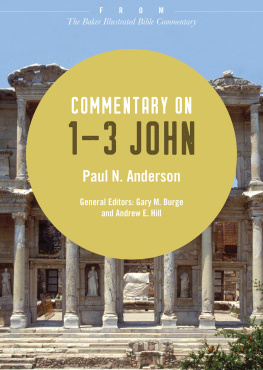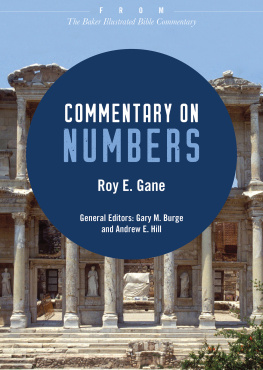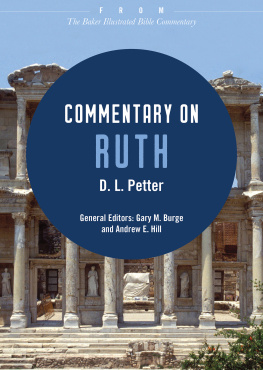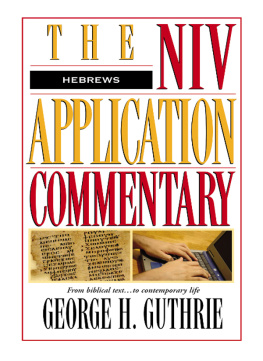Copyright Page
2012 by Baker Publishing Group
Published by Baker Books
a division of Baker Publishing Group
P.O. Box 6287, Grand Rapids, MI 49516-6287
www.bakerbooks.com
Ebook short created 2019
Previously published in The Baker Illustrated Bible Commentary edited by Gary M. Burge and Andrew E. Hill in 2012
All rights reserved. No part of this publication may be reproduced, stored in a retrieval system, or transmitted in any form or by any meansfor example, electronic, photocopy, recordingwithout the prior written permission of the publisher. The only exception is brief quotations in printed reviews.
Library of Congress Cataloging-in-Publication Data is on file at the Library of Congress, Washington, DC.
ISBN 978-1-4934-2476-4
Unless otherwise indicated, Scripture quotations are from the Holy Bible, New International Version. NIV. Copyright 1973, 1978, 1984, 2011 by Biblica, Inc. Used by permission of Zondervan. All rights reserved worldwide. www.zondervan.com. The NIV and New International Version are trademarks registered in the United States Patent and Trademark Office by Biblica, Inc.
Scripture quotations labeled ESV from The Holy Bible, English Standard Version (ESV), copyright 2001 by Crossway, a publishing ministry of Good News Publishers. Used by permission. All rights reserved. ESV Text Edition: 2007
Scripture quotations labeled NASB are from the New American Standard Bible, copyright 1960, 1962, 1963, 1968, 1971, 1972, 1973, 1975, 1977, 1995 by The Lockman Foundation. Used by permission. www.lockman.org
Scripture quotations labeled NIV 1984 are from the HOLY BIBLE, NEW INTERNATIONAL VERSION. NIV. Copyright 1973, 1978, 1984 by International Bible Society. Used by permission of Zondervan. All rights reserved.
Scripture quotations labeled NJPS are from the New Jewish Publication Society Version 1985 by The Jewish Publication Society. All rights reserved.
Scripture quotations labeled NKJV are from the New King James Version. Copyright 1982 by Thomas Nelson, Inc. Used by permission. All rights reserved.
Scripture quotations labeled NLT are from the Holy Bible , New Living Translation, copyright 1996, 2004, 2007 by Tyndale House. Used by permission of Tyndale House Publishers, Inc., Carol Stream, Illinois 60188. All rights reserved.
Scripture quotations labeled NRSV are from the New Revised Standard Version of the Bible, copyright 1989, by the Division of Christian Education of the National Council of the Churches of Christ in the United States of America. Used by permission. All rights reserved.
Scripture quotations labeled RSV are from the Revised Standard Version of the Bible, copyright 1952 [2nd edition, 1971] by the Division of Christian Education of the National Council of the Churches of Christ in the United States of America. Used by permission. All rights reserved.
Unless otherwise indicated, photos, illustrations, and maps are copyright Baker Photo Archive.
Contents
Abbreviations
| ANET | Ancient Near Eastern Texts Relating to the Old Testament . Edited by J. B. Pritchard. 3rd ed. Princeton, 1969 |
| BDAG | Bauer, W., F. W. Danker, W. F. Arndt, and F. W. Gingrich. Greek-English Lexicon of the New Testament and Other Early Christian Literature. 3rd ed. Chicago, 1999 |
| ca. | circa (about, approximately) |
| cf. | compare |
| chap(s). | chapter(s) |
| COS | The Context of Scripture . Edited by W. W. Hallo. 3 vols. Leiden, 1997 |
| e.g. | for example |
| ESV | English Standard Version |
| HALOT | Koehler, L., W. Baumgartner, and J. J. Stamm. The Hebrew and Aramaic Lexicon of the Old Testament. Translated and edited under the supervision of M. E. J. Richardson. 5 vols. Leiden, 19942000 |
| HCSB | Holman Christian Standard Bible |
| i.e. | that is |
| KJV | King James Version |
| NASB | New American Standard Bible |
| NEB | New English Bible |
| NET | New English Translation |
| NIV | New International Version (2011 edition) |
| NIV 1984 | New International Version (1984 edition) |
| NJB | New Jerusalem Bible |
| NJPS | The Tanakh: The Holy Scriptures: The New JPS Translation according to the Traditional Hebrew Text |
| NKJV | New King James Version |
| NLT | New Living Translation |
| NRSV | New Revised Standard Version |
| RSV | Revised Standard Version |
| TDOT | Theological Dictionary of the Old Testament . Edited by G. J. Botterweck and H. Ringgren. Translated by J. T. Willis, G. W. Bromiley, and D. E. Green. 8 vols. Grand Rapids, 1974 |
| TNIV | Todays New International Version |
Hebrews
Robert S. Rayburn
Introduction
Authorship
Although the Letter to the Hebrews was clearly written to address a spiritual crisis in a specific community of Christians by one well known to them, one cannot determine with certainty the identity of the author, the specific recipients or the location of their community, or the precise date of the letters composition.
Though the letter has been ascribed to Paul from at least the end of the second century in the Eastern church and nearly universally in Christendom from Augustine to the Reformation, the arguments against Pauline authorship now appear to be decisive. Chief among them are the following: (1) the letter is anonymous, which is uncharacteristic of Paul; (2) the style of Greek is significantly different from that of Pauls letters; (3) the statement of Hebrews 2:3 seems impossible to reconcile with Galatians 1:12; and (4) the ambiguous testimony of the early fathers: Clement of Alexandria and Origen accepted Hebrews as Pauline but with major qualifications; Tertullian named Barnabas as the author and gave no hint of a controversy on that pointdifficult to explain if the author were none other than the great apostle to the Gentiles.

The reference to Timothy (Heb. 13:23) and the ancient but inconsistent testimony to Pauline authorship have led to the widespread opinion that the author was at least a member of the Pauline circle. Origen suggested that he was a pupil of Paul who wrote what he had learned from the apostle. Others have proposed Luke either as the author or, as Clement of Alexandria supposed, the translator of Pauls Hebrew original. Most modern scholarly opinion, however, is divided between Barnabas and Apollos. Barnabas was a Hellenistic Jew, a Levite in fact, a prominent member of the apostolic circle (even called an apostle in Acts 14:14; cf. 1 Cor. 9:56), and has the considerable support of Tertullians unqualified assertion that Barnabas was the author of Hebrews ( On Modesty 20). Likewise Apollos, a highly educated Alexandrian Jew, a gifted controversialist, and a participant in the apostolic ministry (1 Cor. 1:12; 3:6), could well have written a work such as Hebrews, with its sophisticated use of Scripture and its elegant Greek. If the author of Hebrews was neither of these men, he was surely like them, a good man, full of the Holy Spirit and faith (Acts 11:24) and a learned man, with a thorough knowledge of the Scriptures (Acts 18:24; cf. 18:28). Plausible arguments can be advanced in favor of either of these and some others, but presently a firm conclusion remains unobtainable.

